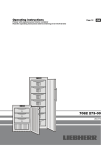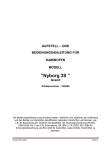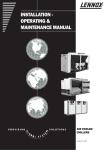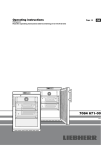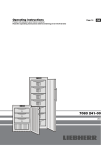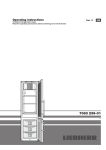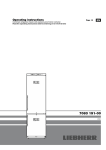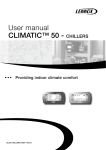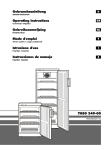Download Liebherr FKUv 1662
Transcript
Operating instructions Commercial refrigerator Page 6 GB 7082 683-00 FKUv 1008 Disposal notes • Keep packaging materials away from children - polythene sheets and bags can cause suffocation! • Please return the packaging to an official collection point. Your old appliance: This contains some reusable materials and should be disposed of properly - not simply with unsorted household refuse. • Discarded appliances should be disabled: Remove the plug, cut through the connection cable and render the catch unusable so that children cannot become trapped inside. • Ensure that the refrigerant circuit is not damaged when the appliance that is no longer needed is taken away for disposal. • Details of the refrigerant can be found on the type plate. • Appliances which are no longer needed must be disposed of in a professional and appropriate way, in accordance with the current local regulations and laws. Range of appliance use The appliance is suited only for cooling food. In the case of commercial food cooling, the pertinent statutory regulations have to be observed. The appliance is not suited for storing and cooling pharmaceuticals, blood plasma, laboratory preparations or similar substances and products subject to the Medical Devices Directive 2007/47/EC. Any misuse of the appliance may result in damage to or spoilage of the stored goods. Furthermore, the appliance is unsuited for use in areas exposed to an explosion hazard. Description of appliance and equipment Operating elements Type plate Grid shelves Safety instructions and warnings • To prevent injury or damage to the unit, the appliance should be unpacked and set up by two people. • In the event that the appliance is damaged on delivery, contact the supplier immediately before connecting to the mains. • To guarantee safe operation, ensure that the appliance is set up and connected as described in these operating instructions. • Disconnect the appliance from the mains if any fault occurs. Pull out the plug, switch off or remove the fuse. • When disconnecting the appliance, pull on the plug, not on the cable. • Any repairs and work on the appliance should only be carried out by the customer service department, as unauthorised work could prove highly dangerous for the user. The same applies to changing the mains power cable. • Do not stand on the plinth, drawers or doors or use them to support anything else. • This appliance is not intended for use by persons (including children) with reduced physical, sensory or mental capabilities or lack of experience and knowledge unless they have been given initial supervision or instruction concerning use of the appliance by a person responsible for their safety. Children should be supervised to ensure that they do not play with the appliance. • Avoid prolonged skin contact with cold surfaces or chilled/frozen food. This could cause pain, numbness and frostbite. In the case of prolonged skin contact, protective measures should be taken, e.g. gloves should be worn. • Do not consume food which has been stored for too long, as it could cause food poisoning. • If you have a lockable appliance, do not keep the key near the appliance or within reach of children. • Do not store explosives or sprays using combustible propellants such as butane, propane, pentane etc. in the appliance. Electrical components might cause leaking gas to ignite. You may identify such sprays by the printed contents or a flame symbol. • Do not allow naked flames or ignition sources to enter the appliance. When transporting and cleaning the appliance ensure that the refrigerant circuit is not damaged. In the event of damage, make sure that there are no ignition sources nearby and keep the room well ventilated. • Do not use electrical appliances inside the appliance. • Do not connect the appliance to the supply with other equipment using an extension cable. This can cause the extension socket to overheat. Climate rating The appliance is set to operate within specific ambient temperature limits according to its climate rating.These temperature limits should not be exceeded. The correct climate rating for your appliance is indicated on the type plate. Climate rating SN N ST T Adjustable- height feet 6 Ambient temperature +10°C to +32°C +16°C to +32°C +16°C to +38°C +16°C to +43°C Setting up • Avoid positioning the appliance in direct sunlight or near cookers, radiators and similar sources of heat. • The floor on which the appliance stands should be horizontal and level.Compensate for uneven floors with the adjustable feet. • Always ensure that there is good ventilation and that the outward flowing air is able to escape. • Standard EN 378 specifies that the room in which you install your appliance must have a volume of 1 m3 per 8 g of R 600a refrigerant used in the appliance, so as to avoid the formation of inflammable gas/air mixtures in the room where the appliance is located in the event of a leak in the refrigerant circuit. The quantity of refrigerant used in your appliance is indicated on the type plate on the inside of the appliance. Connecting to the mains Power supply (a.c.) and voltage at the operating point must comply with the details on the type plate. The socket must be fused with a 10 A fuse or higher, it must be away from the rear of the appliance and must be easily accessible. Connect the appliance with a properly earthed fused plug and socket only. Operating and control elements GB Cooling This appliance can be used for chilling all types of drinks and food. The grid shelves can be moved to accommodate different height bottles or packages. High-percentage alcohols should be tightly sealed and stored upright. The ventilation slots on the inside must not be covered! Cooling with fan This generates relatively even temperatures on all of the shelves; all food will be chilled to the same temperature, which you can select. The forced air circulation eliminates the different temperature areas present in normal operation. It is generally recommended: - in high room temperatures (approx. 30°C and higher), - if the air humidity is high, e.g. during the summer. To switch on: Press the Ventilation To switch off: Press the Ventilation button. The LED will come on. button. The LED goes dark. Audible warning signal 1Temperature setting buttons 2On/off button 3Ventilation button 4Audible warning on/off button 5Temperature display 6Ventilation LED 7Childproof Lock LED Switching the appliance on and off You are recommended to clean the appliance before switching it on for the first time (see "Cleaning"). • To switch the appliance on: Press the ON/OFF button until the temperature display lights up. • To switch the appliance off: Press the ON / OFF button for approx. two seconds so that the temperature display goes out. It sounds when the door has been left open for longer than about 60 seconds. Press the audible warning on/off button to cancel the alarm. The alarm switches back to standby when the door is shut. It sounds when the interior gets too warm or too cold. The temperature display will also flash. The audible warning device is switched off by pressing the Alarm button. The temperature display will continue to flash until the cause of the alarm has been rectified. Safety lock The lock in the appliance door is equipped with a safety mechanism. Locking the appliance: • Insert the key as shown by arrow 1. • Turn the key 90°. To unlock the appliance, the same procedure must be repeated in the same order. Setting the temperature • To increase the temperature: Press the UP button. • To reduce the temperature: Press the DOWN button. - While you are entering the temperature, the set temperature will flash on the display. - You can change the settings in increments of 1°C briefly pressing the button again. - The electronic controls will switch over automatically about 5 seconds after the last time you pressed the button, and the actual temperature will be displayed. 7 Child-proof lock Cleaning Switching on the child-proof lock Clean the inside, equipment parts and outer walls with lukewarm water and a little detergent. Do not use abrasive or acid cleaners or chemical solvents. The child-proof lock is designed to protect the appliance from being switched off accidentally. • Keep the "Ventilation" button pressed for 3 sec. - The display reads c ( c flashes) • Press the "Ventilation" button - The display reads c0 ( 0 flashes) • Press the Up button - The display reads c1 ( 1 flashes) • Press the "Ventilation" button - The LED will come on ( c flashes) • Press the "ON / OFF" button. The child-proof lock is now switched on. Switching off the child-proof lock • Keep the "Ventilation" button pressed for 3 sec. - The display reads c ( c flashes) • Press the "Ventilation" button - The display reads c1 • Press the Down button - The display reads c0 ( 1 flashes) ( 0 flashes) • Press the "Ventilation" button - The LED goes dark ( c flashes) • Press the "ON / OFF" button. The child-proof lock is now switched off. Interior light in appliances with glass door The light consists of a fluorescent tube with an integrated starter and is located at the top of the interior. Switch on switch S, the interior light comes on. To change the tube: Pull out the mains plug or remove/unscrew the fuse. • lever out the cover panel ➀ on the lamp housing at the front and remove downwards. • Turn the tube ➁ 90° and pull out downwards. Insert a new tube and turn 90°. • Replace the cover panel ➀ by inserting at the back and clicking into place at the front. If the interior light still does not work after you have changed the bulb, please consult your nearest customer service point. Defrosting The appliance defrosts automatically. The water that forms on the rear wall drains into a reservoir at the back of the appliance and evaporates automatically through the compressor heat. 8 Before cleaning always switch off the appliance. Pull out the mains plug or remove/unscrew the fuse. Do not use steam cleaners because of the risk of injury and damage. • Ensure that no cleaning water penetrates into the electrical components or ventilation grille. • Dry all parts well with a cloth. • Do not damage or remove the type plate on the inside of the appliance. It is very important for servicing purposes. • Use a commercially available stainless-steel cleaning agent for stainless-steel appliances. - In order to achieve best possible protection, apply a stainless-steel care agent uniformly in grinding direction after cleaning. - Do not use abrasive sponges or scourers, do not use concentrated cleaning agents and never use cleaning agents containing sand, chloride or acid or chemical solvents, as these would damage the surfaces and could cause corrosion. Malfunctions You may be able to rectify the following faults by checking the possible causes yourself: • Appliance does not function: – Is the appliance switched on? – Is the plug correctly fitted in the mains socket? – Is the socket fuse intact? • Loud running noise: – Is the appliance set up firmly on the floor? – Does the appliance cause nearby items of furniture or objects to vibrate? Ensure that the appliance is stable and that all parts at the back can vibrate freely.Please note that noises caused by the refrigerant circuit cannot be avoided. • The temperature is not low enough: – Is the temperature setting correct (see „Setting the temperature“)? – Does the separately installed thermometer show the correct reading? – Is the ventilation system working properly? – Is the appliance set up too close to a heat source? If none of the above causes apply and you cannot rectify the fault yourself, contact the nearest customer service department stating the type of appliance ➊, service number ➋ and appliance number ➌ as indicated on the type plate. Shutting your appliance down If your appliance is to be shut down for any length of time, switch it off and disconnect the plug or remove the fuse. Clean the appliance and leave the door open in order to prevent unpleasant smells. The appliance complies with the relevant safety regulations and EC directives 2004/108/EC and 2006/95/EC. All types and models are subject to continuous improvement and the manufacturer therefore reserves the right to make modifications to the shape, equipment and technology. Changing over door hinges 1. Unscrew the hinge bracket. Achtung: Das Türlager hat einen Federmechanismus zum Selbstschließen der Tür. Beim Lösen der Schrauben dreht sich der Scharnierwinkel nach links. Installation dimensions (mm) GB Version 1 A cross-section of min. 200 cm2 is required in the worktop for ventilation of the rear of the appliance. 2. Pull the door out at the bottom and lift off. 3. Transfer handle and plugs to the opposite side of the door. 4. Transfer pin on hinge bracket to the opposite side. Version 2 If no ventilation grill is provided in the worktop, the recess must be at least 860 mm high to ensure adequate heat dissipation to the front. 5. Move the pin at the top to the other side. 6. Transfer cover plate to the opposite side. 7. Mount door on hinge pin and close. 8. Insert hinge bracket in lower door mounting and screw into place. 9. Scharnierwinkel um 90° drehen - Feder wird gespannt. Scharnierwinkel anschrauben. 9





